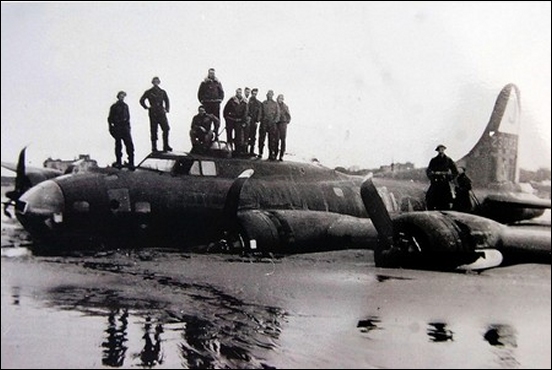Walter Skinner, the final survivor of the crew of an American B17 Flying Fortress which crash-landed on Burnham-On-Sea beach on December 31st, 1943, has died peacefully back home in the United States.
He never forgot the town that came to the help of the crew and offered hospitality that fateful night, and even returned to thank Burnham’s residents in 1995.
Iris Rowe of Westonzoyland, who has specialised in tracing and recording the memories of American servicemen who served in the UK during World World War Two, met Mr Skinner several times.
She recalled his life in an interview with the Western Daily Press. “It was Walt who solved the mystery of the American plane that crash-landed on Burnham beach, and launched my later-life career as a military historian. He was a very modest man, embarrassed by the attention he got in Burnham in 1995.”
“Walt wrote to the people of Burnham in December 1989 to thank them for their hospitality during the four days he and his crew spent there following their beach landing. He also wanted to apologise to the family who had invited him to their home, an invitation he was forced to refuse because a truck had been sent that day from their base at Polebrook, Northamptonshire, to take them back to base and back to flying more missions.”
“Walt was the flight engineer/top turret gunner and would have to stand throughout the mission. During take-off he stood behind and between the two pilots so that he could check the instruments. Once in the air, he took up his position as the top turret gunner, standing on a small piece of raised metal with his head into the perspex dome above the plane and armed with two .50 calibre machine guns to protect the plane from attacks from above.”
“If any of the crew was wounded it was his job to do what he could for them. To get to the back of the plane, where six airmen were positioned, he had to go through the bomb bay by means of a four inch walkway – no room for a parachute to be worn, and using a walk around oxygen bottle. If a bomb got hung-up it was his job to try to kick it free, standing above the open bomb bay doors. One slip and he would be gone.”
“He and his crewmates were serving with the 351st Battle Group which had suffered many losses due to mid-air collisions. The December 31st mission was considered to be a milk-run as little or no opposition was expected and so they were to fly at a lower than normal altitude with several top brass flying the lead plane, checking on the formation flying.”
“It was anything but a milk run. It was the longest mission and most costly in men and planes throughout the war for the 351st Battle Group. A total of 296 planes headed for German-held targets in France. The 351st and 401st Battle Groups flew towards their targets of Bordeaux/Cognac whilst the others flew south. As they approached Bordeaux they were attacked by a group of FW190s. Bordeaux was cloud covered and so the B-17s headed north to their secondary target of Cognac where they were attacked by guns from a train and from a ship. Four planes went down in the target area, one in the Atlantic and two in the English Channel.”
“Walt and his crew, with one engine smoking, survived a fighter attack over the Brest peninsular and, short of fuel and alone, desperately looked for some place to land. They were too low for the crew to bale out and, expecting the pilots to ditch the plane, all except the two pilots took up their crash positions. Flying over St Andrew’s church the pilots saw the beach and made a successful wheels-up landing. As Walt said, ‘we didn’t even get our feet wet’.”
“Many people ran out to the plane as it skidded to a halt, with boys gathering as many souvenirs as they could. Bits of the plane ended up in sheds all over Burnham but a camera only came to light in recent years. Walt and his crew stayed together and carried out 26 more missions. For the remainder of their missions they flew in a B-17 named Black Magic. Several weeks after the plane was assigned to another crew it went down with the loss of the crew.”
“The first and only time Walt came back to Burnham was in May 1995. The head teacher of St Andrew’s Junior School, Steve James, arranged a concert based on the war as tribute to Walt. Mayor, councillor Brenda Brown, gave him a civic reception and invited him and his family to the 50th anniversary ceremony in the Manor Gardens. It was a day Walt never forgot. In 2004, the 60th anniversary of the crash, a plaque was erected at St Andrew’s. The plaque was funded equally by Burnham council and myself. MP David Heathcoat-Amory unveiled it in the company of the chairman of Sedgemoor council, the mayor of Burnham and representatives of the police and fire brigade, plus many of those who saw the plane come down. Walt was unable to come over, due to illness, and so he made a tape recording that was played at the ceremony.”
“It was unusual for a woman to be doing research, and many veterans were suspicious of my asking so many questions. To reassure them I wasn’t looking for my father or an old boyfriend I explained that I had been too young for silk stockings and too shy to ask for chewing gum. Walt promptly sent over five packets of gum, which I still have.”
Walt is survived by a daughter, a son and three grandchildren. He died in the Delaware Veterans Home and was given full military honours.
Meanwhile, one of the first boys to reach the B52 also died last month. Fred Dyson’s family ran an ice cream stall on the beach and he was one of the first to help those in the plane out.







